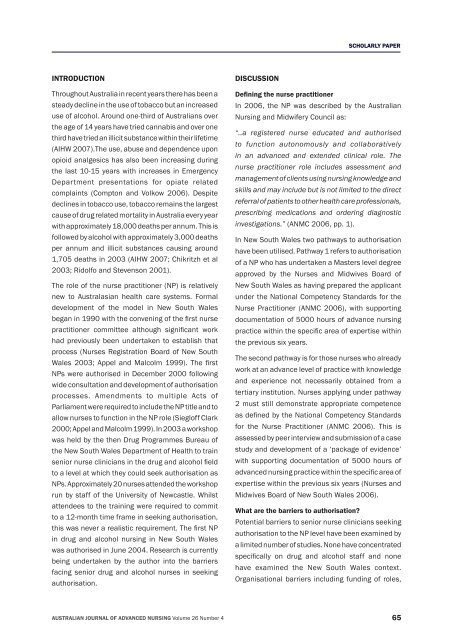australian journal of advanced nursing
australian journal of advanced nursing
australian journal of advanced nursing
You also want an ePaper? Increase the reach of your titles
YUMPU automatically turns print PDFs into web optimized ePapers that Google loves.
INTRODUCTION<br />
Throughout Australia in recent years there has been a<br />
steady decline in the use <strong>of</strong> tobacco but an increased<br />
use <strong>of</strong> alcohol. Around one‑third <strong>of</strong> Australians over<br />
the age <strong>of</strong> 14 years have tried cannabis and over one<br />
third have tried an illicit substance within their lifetime<br />
(AIHW 2007).The use, abuse and dependence upon<br />
opioid analgesics has also been increasing during<br />
the last 10‑15 years with increases in Emergency<br />
Department presentations for opiate related<br />
complaints (Compton and Volkow 2006). Despite<br />
declines in tobacco use, tobacco remains the largest<br />
cause <strong>of</strong> drug related mortality in Australia every year<br />
with approximately 18,000 deaths per annum. This is<br />
followed by alcohol with approximately 3,000 deaths<br />
per annum and illicit substances causing around<br />
1,705 deaths in 2003 (AIHW 2007; Chikritzh et al<br />
2003; Ridolfo and Stevenson 2001).<br />
The role <strong>of</strong> the nurse practitioner (NP) is relatively<br />
new to Australasian health care systems. Formal<br />
development <strong>of</strong> the model in New South Wales<br />
began in 1990 with the convening <strong>of</strong> the first nurse<br />
practitioner committee although significant work<br />
had previously been undertaken to establish that<br />
process (Nurses Registration Board <strong>of</strong> New South<br />
Wales 2003; Appel and Malcolm 1999). The first<br />
NPs were authorised in December 2000 following<br />
wide consultation and development <strong>of</strong> authorisation<br />
processes. Amendments to multiple Acts <strong>of</strong><br />
Parliament were required to include the NP title and to<br />
allow nurses to function in the NP role (Siegl<strong>of</strong>f Clark<br />
2000; Appel and Malcolm 1999). In 2003 a workshop<br />
was held by the then Drug Programmes Bureau <strong>of</strong><br />
the New South Wales Department <strong>of</strong> Health to train<br />
senior nurse clinicians in the drug and alcohol field<br />
to a level at which they could seek authorisation as<br />
NPs. Approximately 20 nurses attended the workshop<br />
run by staff <strong>of</strong> the University <strong>of</strong> Newcastle. Whilst<br />
attendees to the training were required to commit<br />
to a 12‑month time frame in seeking authorisation,<br />
this was never a realistic requirement. The first NP<br />
in drug and alcohol <strong>nursing</strong> in New South Wales<br />
was authorised in June 2004. Research is currently<br />
being undertaken by the author into the barriers<br />
facing senior drug and alcohol nurses in seeking<br />
authorisation.<br />
DISCUSSION<br />
Defining the nurse practitioner<br />
SCHOLARLY PAPER<br />
In 2006, the NP was described by the Australian<br />
Nursing and Midwifery Council as:<br />
“..a registered nurse educated and authorised<br />
to function autonomously and collaboratively<br />
in an <strong>advanced</strong> and extended clinical role. The<br />
nurse practitioner role includes assessment and<br />
management <strong>of</strong> clients using <strong>nursing</strong> knowledge and<br />
skills and may include but is not limited to the direct<br />
referral <strong>of</strong> patients to other health care pr<strong>of</strong>essionals,<br />
prescribing medications and ordering diagnostic<br />
investigations.” (ANMC 2006, pp. 1).<br />
In New South Wales two pathways to authorisation<br />
have been utilised. Pathway 1 refers to authorisation<br />
<strong>of</strong> a NP who has undertaken a Masters level degree<br />
approved by the Nurses and Midwives Board <strong>of</strong><br />
New South Wales as having prepared the applicant<br />
under the National Competency Standards for the<br />
Nurse Practitioner (ANMC 2006), with supporting<br />
documentation <strong>of</strong> 5000 hours <strong>of</strong> advance <strong>nursing</strong><br />
practice within the specific area <strong>of</strong> expertise within<br />
the previous six years.<br />
The second pathway is for those nurses who already<br />
work at an advance level <strong>of</strong> practice with knowledge<br />
and experience not necessarily obtained from a<br />
tertiary institution. Nurses applying under pathway<br />
2 must still demonstrate appropriate competence<br />
as defined by the National Competency Standards<br />
for the Nurse Practitioner (ANMC 2006). This is<br />
assessed by peer interview and submission <strong>of</strong> a case<br />
study and development <strong>of</strong> a ‘package <strong>of</strong> evidence’<br />
with supporting documentation <strong>of</strong> 5000 hours <strong>of</strong><br />
<strong>advanced</strong> <strong>nursing</strong> practice within the specific area <strong>of</strong><br />
expertise within the previous six years (Nurses and<br />
Midwives Board <strong>of</strong> New South Wales 2006).<br />
What are the barriers to authorisation?<br />
Potential barriers to senior nurse clinicians seeking<br />
authorisation to the NP level have been examined by<br />
a limited number <strong>of</strong> studies. None have concentrated<br />
specifically on drug and alcohol staff and none<br />
have examined the New South Wales context.<br />
Organisational barriers including funding <strong>of</strong> roles,<br />
AUSTRALIAN JOURNAL OF ADVANCED NURSING Volume 26 Number 4 65

















